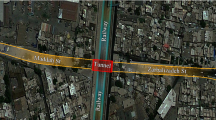Abstract
The uncertainty in the spatial distributions of consolidation settlement (s c) and time (t p) for Songdo New City is evaluated by using a probabilistic procedure. Ordinary kriging and three theoretical semivariogram models are used to estimate the spatial distributions of geo-layers which affect s c and t p in this study. The spatial map of mean (μ) and standard deviation (σ) for s c and t p are determined by using a first-order second moment method based on the evaluated statistics and probability density functions (PDFs) of soil properties. It is shown that the coefficients of variation (COVs) of the compression ratio [C c/(1 + e 0)] and the coefficient of consolidation (c v) are the most influential factors on the uncertainties of s c and t p, respectively. The μ and σ of the s c and t p, as well as the probability that s c exceeds 100 cm [P(s c > 100 cm)] and the probability that t p exceeds 36 months [P(t p > 36 months)] in Sect. 1, are observed to be larger than those of other sections because the thickness of the consolidating layer in Sect. 1 is the largest in the entire study area. The area requiring additional fill after the consolidation appears to increase as the COV of C c/(1 + e 0) increases and as the probabilistic design criterion (α) decreases. It is also shown that the area requiring the prefabricated vertical drains installation increases as the COV of c v increases and as the α decreases. The design procedure presented in this paper could be used in the decision making process for the design of geotechnical structures at coastal reclamation area.

















Similar content being viewed by others
References
Ang AH-S, Tang WH (1975) Probability concepts in engineering planning and design, Vol. 1-Basic principles. Wiley, New York
Athanasiou-Grivas D, Harr ME (1978) Consolidation—a probabilistic approach. J Eng Mech Division ASCE 104(EM3):681–690
Baecher GB, Christian JT (2003) Reliability and statistical in geotechnical engineering. Wiley, New York, pp 177–203
Baise LG, Higgins RB, Brankman CM (2006) Liquefaction hazard mapping-statistical and spatial characterization of susceptible units. J Geotech Geoenviron Eng ASCE 132(6):705–715
Benjamin JR, Cornell CA (1970) Probability, statistics, and decision for civil engineers. McGraw-Hill Book Company, New York
Chang CS (1985) Uncertainty of one-dimensional consolidation analysis. J Geotech Eng ASCE 111(12):1411–1424
Chiasson P, Lafleur J, Soulie M, Law KT (1995) Characterizing spatial variability of a clay by geostatistics. Can Geotech J 32(1):1–10
Christakos G (1985) Modern statistical analysis and optimal estimation of geotechnical data. Eng Geol 22:175–200
Corotis RB, Krizek RJ, El-Moursi HH (1975) Probabilistic approach to prediction of consolidation settlement. TRB Transportation Research Board 548:47–61
Cressie N (1991) Statistics for spatial data. Wiley, New York
Duncan J (2000) Factors of safety and reliability in geotechnical engineering. J Geotech Geoenviron Eng ASCE 126(4):307–316
Deutsch CV (1989) DECLUS: a Fortran 77 program for determining optimum spatial declustering weights. Comput Geosci 15(3):325–332
Deutsch CV, Journel AG (1992) GSLIB: Geostatistical software library and user’s guide. Oxford University Press, New York
Freeze RA (1977) Probabilistic one-dimensional consolidation. J Geotech Eng Div ASCE 103(GT7):725–741
Goovaerts P (1997) Geostatistics for natural resources evaluation. Oxford University Press, New York
Holtz RD, Kovacs WD, Sheahan TC (2011) An introduction to geotechnical engineering, 2nd edn. Pearson, New York
Hong HP, Shang JQ (1998) Probabilistic analysis of consolidation with prefabricated vertical drains for soil improvement. Can Geotech J 35(4):666–677
Huang J, Griffiths DV, Fenton GA (2010) Probabilistic analysis of coupled soil consolidation. J Geotech Geoenviron Eng ASCE 136(3):417–430
Isaaks EH, Srivastava RM (1989) Applied geostatistics. Oxford University Press, New York
Jaksa MB, Brooker PI, Kaggwa WS (1997) Modeling the spatial variation of the undrained shear strength of clays soils using geostatistics. In: Proceedings of 5th international Geostatistics Congress, Kulwer Academic, Dordrecht, The Netherlands, pp 1284–1295
Journel AG, Huijbregts CJ (1978) Mining geostatistics. Academic Press, London
Kim D, Kim KS, Ko S, Choi Y, Lee W (2012) Assessment of geotechnical variability of Songdo silty clay. Eng Geol 133–134:1–8
Marache A, Breysse D, Piette C, Thierry P (2009) Geotechnical modeling at the city scale using statistical and geostatistical tools: the Pressac case (France). Eng Geol 107:67–76
Mendes RM, Lorandi R (2008) Analysis of spatial variability of SPT penetration resistance in collapsible soils considering water table depth. Eng Geol 101:218–225
Mesri G, Choi YK (1985) Settlement analysis of embankments on soft clays. J Geotech Eng ASCE 111(4):441–464
Parsons RL, Frost JD (2002) Evaluating site investigation quality using GIS and geostatistics. J Geotech Geoenviron Eng ASCE 128(6):451–461
Phoon KK, Kulhawy FH (1999) Characterization of geotechnical variability. Can Geotech J 36(4):612–624
Santra P, Chopra UK, Chakraborty D (2008) Spatial variability of soil properties and its application in predicting surface map of hydraulic parameters in agricultural farm. Curr Sci 95(7):937–945
Soulie M, Montes P, Silvestri V (1990) Modelling spatial variability of soil parameters. Can Geotech J 27(5):617–630
Taylor DW (1948) Fundamentals of soil mechanics. Wiley, New York
Zhou W, Hong HP, Shang JQ (1999) Probabilistic design method of prefabricated vertical drains for soil improvement. J Geotech Geoenviron Eng ASCE 125(8):659–664
Acknowledgments
This paper was financially supported by a POSCO E&C grant and the authors wish to thank POSCO E&C Co.
Author information
Authors and Affiliations
Corresponding author
Rights and permissions
About this article
Cite this article
Kim, D., Ryu, D., Lee, C. et al. Probabilistic evaluation of primary consolidation settlement of Songdo New City by using kriged estimates of geologic profiles. Acta Geotech. 8, 323–334 (2013). https://doi.org/10.1007/s11440-012-0192-5
Received:
Accepted:
Published:
Issue Date:
DOI: https://doi.org/10.1007/s11440-012-0192-5




